Minivelle
NOVEN THERAPEUTICS, LLC
Noven Pharmaceuticals, Inc.
HIGHLIGHTS OF PRESCRIBING INFORMATION BOXED WARNINGWARNING: ENDOMETRIAL CANCER, CARDIOVASCULAR DISORDERS, BREAST CANCER AND PROBABLE DEMENTIA See full prescribing information for complete boxed warning. Estrogen-Alone Therapy There is an increased risk of endometrial cancer in a woman with a uterus who uses unopposed estrogens (5.2) Estrogen-alone therapy should not be used for the prevention of cardiovascular disease or dementia (5.1, 5.3) The Women’s Health Initiative (WHI) estrogen-alone substudy reported increased risks of stroke and deep vein thrombosis (DVT) (5.1) The WHI Memory Study (WHIMS) estrogen-alone ancillary study of WHI reported an increased risk of probable dementia in postmenopausal women 65 years of age and older (5.3) Estrogen Plus Progestin Therapy Estrogen plus progestin therapy should not be used for the prevention of cardiovascular disease or dementia (5.1, 5.3) The WHI estrogen plus progestin substudy reported increased risks of stroke, DVT, pulmonary embolism (PE), and myocardial infarction (MI) (5.1) The WHI estrogen plus progestin substudy reported increased risks of invasive breast cancer (5.2) The WHIMS estrogen plus progestin ancillary study of WHI reported an increased risk of probable dementia in postmenopausal women 65 years of age and older (5.3) INDICATIONS AND USAGE MINIVELLE is an estrogen indicated for the treatment of moderate to severe vasomotor symptoms due to menopause (1.1). DOSAGE AND ADMINISTRATION Start therapy with MINIVELLE 0.0375 mg per day applied to the skin twice weekly. Dosage adjustment should be guided by the clinical response (2.1) MINIVELLE should be placed on a clean, dry area on the lower abdomen (below the umbilicus) or buttocks. MINIVELLE should not be applied to the breasts (2.1) DOSAGE FORMS AND STRENGTHS Transdermal system 0.0375 mg/day, 0.05 mg/day, 0.075 mg/day, and 0.1 mg/day (3) CONTRAINDICATIONS Undiagnosed abnormal genital bleeding (4) Known, suspected, or history of breast cancer (4, 5.2) Known or suspected estrogen-dependent neoplasia (4, 5.2) Active DVT, PE, or a history of these conditions (4, 5.1) Active arterial thromboembolic disease (for example, stroke and MI), or a history of these conditions (4, 5.1) Known anaphylactic reaction or angioedema with MINIVELLE (4) Known liver impairment (4, 5.10) Known protein C, protein S, or antithrombin deficiency, or other known thrombophilic disorders (4) Known or suspected pregnancy (4, 8.1) WARNINGS AND PRECAUTIONS Estrogens increase the risk of gallbladder disease (5.4) Discontinue estrogen if severe hypercalcemia, loss of vision, severe hypertriglyceridemia or cholestatic jaundice occurs (5.5, 5.6, 5.9, 5.10) Monitor thyroid function in women on thyroid replacement therapy (5.11, 5.18) Side EffectsMost common adverse reactions (≥5 percent) with Vivelle are: headache, breast tenderness, back pain, pain in limb, nasopharyngitis, dyspepsia, nausea, sinusitis, intermenstrual bleeding. (6.1) To report SUSPECTED ADVERSE REACTIONS, contact Noven at 1-800-455-8070 or FDA at 1-800-FDA-1088 or www.fda.gov/medwatch DRUG INTERACTIONS Inducers and/or inhibitors of CYP3A4 may affect estrogen drug metabolism (7.1) USE IN SPECIFIC POPULATIONS Nursing Mothers: Estrogen administration to nursing women has been shown to decrease the quantity and quality of breast milk (8.3) Geriatric Use: An increased risk of probable dementia in women over 65 years of age was reported in the Women’s Health Initiative Memory ancillary studies of the Women’s Health Initiative (5.3, 8.5)
FULL PRESCRIBING INFORMATION: CONTENTS*
- WARNING: ENDOMETRIAL CANCER, CARDIOVASCULAR DISORDERS, BREAST CANCER AND PROBABLE DEMENTIA
- 1. MINIVELLE INDICATIONS AND USAGE
- 2. MINIVELLE DOSAGE AND ADMINISTRATION
- 3. DOSAGE FORMS AND STRENGTHS
- 4. MINIVELLE CONTRAINDICATIONS
- 5. WARNINGS AND PRECAUTIONS
- 5.1 Cardiovascular Disorders
- 5.2 Malignant Neoplasms
- 5.3 Probable Dementia
- 5.4 Gallbladder Disease
- 5.5 Hypercalcemia
- 5.6 Visual Abnormalities
- 5.7 Addition of a Progestin When a Woman Has Not Had a Hysterectomy
- 5.8 Elevated Blood Pressure
- 5.9 Hypertriglyceridemia
- 5.10 Hepatic Impairment and/or Past History of Cholestatic Jaundice
- 5.11 Hypothyroidism
- 5.12 Fluid Retention
- 5.13 Hypocalcemia
- 5.14 Exacerbation of Endometriosis
- 5.15 Hereditary Angioedema
- 5.16 Exacerbation of Other Conditions
- 5.17 Laboratory Tests
- 5.18 Drug-Laboratory Test Interactions
- 6. MINIVELLE ADVERSE REACTIONS
- 7. DRUG INTERACTIONS
- 8. USE IN SPECIFIC POPULATIONS
- 10. OVERDOSAGE
- 11. MINIVELLE DESCRIPTION
- 12. CLINICAL PHARMACOLOGY
- 13. NONCLINICAL TOXICOLOGY
- 14. CLINICAL STUDIES
- 15. REFERENCES
- 16. HOW SUPPLIED/STORAGE AND HANDLING
- 17. PATIENT COUNSELING INFORMATION
FULL PRESCRIBING INFORMATION
WARNING: ENDOMETRIAL CANCER, CARDIOVASCULAR DISORDERS, BREAST CANCER AND PROBABLE DEMENTIA
Estrogen-Alone Therapy
Endometrial Cancer
There is an increased risk of endometrial cancer in a woman with a uterus who uses unopposed estrogens. Adding a progestin to estrogen therapy has been shown to reduce the risk of endometrial hyperplasia, which may be a precursor to endometrial cancer. Adequate diagnostic measures, including directed or random endometrial sampling when indicated, should be undertaken to rule out malignancy in postmenopausal women with undiagnosed persistent or recurring abnormal genital bleeding [see Warnings and Precautions (5.2)].
Cardiovascular Disorders and Probable Dementia
Estrogen-alone therapy should not be used for the prevention of cardiovascular disease or dementia [see Warnings and Precautions (5.1, 5.3), and Clinical Studies (14.2, 14.3)].
The Women’s Health Initiative (WHI) estrogen-alone substudy reported increased risks of stroke and deep vein thrombosis (DVT) in postmenopausal women (50 to 79 years of age) during 7.1 years of treatment with daily oral conjugated estrogens (CE) [0.625 mg]-alone, relative to placebo [see Warnings and Precautions (5.1), and Clinical Studies (14.2)].
The WHI Memory Study (WHIMS) estrogen-alone ancillary study of WHI reported an increased risk of developing probable dementia in postmenopausal women 65 years of age or older during 5.2 years of treatment with daily CE (0.625 mg)-alone, relative to placebo. It is unknown whether this finding applies to younger postmenopausal women [see Warnings and Precautions (5.3), Use in Specific Populations (8.5), and Clinical Studies (14.3)].
In the absence of comparable data, these risks should be assumed to be similar for other doses of CE and other dosage forms of estrogens.
Estrogens with or without progestins should be prescribed at the lowest effective doses and for the shortest duration consistent with treatment goals and risks for the individual woman.
Estrogen Plus Progestin Therapy
Cardiovascular Disorders and Probable Dementia
Estrogen plus progestin therapy should not be used for the prevention of cardiovascular disease or dementia [see Warnings and Precautions (5.1, 5.3), and Clinical Studies (14.2, 14.3].
The WHI estrogen plus progestin substudy reported increased risks of DVT, pulmonary embolism (PE), stroke and myocardial infarction (MI) in postmenopausal women (50 to 79 years of age) during 5.6 years of treatment with daily oral CE (0.625 mg) combined with medroxyprogesterone acetate (MPA) [2.5 mg], relative to placebo [see Warnings and Precautions (5.1), and Clinical Studies (14.2)].
The WHIMS estrogen plus progestin ancillary study of the WHI, reported an increased risk of developing probable dementia in postmenopausal women 65 years of age or older during 4 years of treatment with daily CE (0.625 mg) combined with MPA (2.5 mg), relative to placebo. It is unknown whether this finding applies to younger postmenopausal women [see Warnings and Precautions (5.3), Use in Specific Populations (8.5), and Clinical Studies (14.3)].
Breast Cancer
The WHI estrogen plus progestin substudy also demonstrated an increased risk of invasive breast cancer [see Warnings and Precautions (5.2), and Clinical Studies (14.2)].
In the absence of comparable data, these risks should be assumed to be similar for other doses of CE and MPA, and other combinations and dosage forms of estrogens and progestins.
Estrogens with or without progestins should be prescribed at the lowest effective doses and for the shortest duration consistent with treatment goals and risks for the individual woman.
1. INDICATIONS AND USAGE
MINIVELLE is indicated for treatment of moderate to severe vasomotor symptoms due to menopause.
2. DOSAGE AND ADMINISTRATION
Generally, when estrogen is prescribed for a postmenopausal woman with a uterus, a progestin should be considered to reduce the risk of endometrial cancer. A woman without a uterus does not need a progestin. In some cases, however, hysterectomized women with a history of endometriosis may need a progestin [see Warnings and Precautions ( 5.2, 5.14 )].
Use of estrogen-alone, or in combination with a progestin, should be with the lowest effective dose and for the shortest duration consistent with treatment goals and risks for the individual woman. Postmenopausal women should be re-evaluated periodically as clinically appropriate to determine if treatment is still necessary.
2.1 Treatment of Moderate to Severe Vasomotor Symptoms
Start therapy with MINIVELLE 0.0375 mg per day applied to the skin twice weekly. Dosage adjustment should be guided by the clinical response.
Therapy should be started at the lowest effective dose and the shortest duration consistent with the treatment goals. Attempts to taper or discontinue the medication should be made at 3 to 6 month intervals.
The adhesive side of MINIVELLE should be placed on a clean, dry area on the lower abdomen (below the umbilicus) or buttocks. MINIVELLE should not be applied to the breasts. MINIVELLE should be replaced twice weekly (every 3-4 days).
The sites of application must be rotated, with an interval of at least 1 week allowed between applications to a particular site.
The area selected should not be oily, damaged, or irritated. The waistline should be avoided, since tight clothing may rub the system off. The system should be applied immediately after opening the pouch and removing the protective liner. The system should be pressed firmly in place with the palm of the hand for about 10 seconds, making sure there is good contact with the skin, especially around the edges. In the event that a system should fall off, the same system may be reapplied. If the same system cannot be reapplied, a new system should be applied to another location. If a woman has forgotten to apply a patch, she should apply a new patch as soon as possible. In either case, the original treatment schedule should be continued. The interruption of treatment in women taking MINIVELLE might increase the likelihood of breakthrough bleeding, spotting and recurrence of symptoms.
3. DOSAGE FORMS AND STRENGTHS
Transdermal system 0.0375 mg/day, 0.05 mg/day, 0.075 mg/day, and 0.1 mg/day.
4. CONTRAINDICATIONS
MINIVELLE is contraindicated in women with any of the following conditions:
- Undiagnosed abnormal genital bleeding
- Known, suspected or history of breast cancer
- Known or suspected estrogen-dependent neoplasia
- Active DVT, PE, or a history of these conditions
- Active arterial thromboembolic disease (for example, stroke, and MI), or a history of these conditions
- Known anaphylactic reaction or angioedema with MINIVELLE
- Known liver impairment
- Known protein C, protein S, or antithrombin deficiency, or other known thrombophilic disorders
- Known or suspected pregnancy
5. WARNINGS AND PRECAUTIONS
5.1 Cardiovascular Disorders
An increased risk of stroke and DVT has been reported with estrogen-alone therapy. An increased risk of PE, DVT, stroke and MI has been reported with estrogen plus progestin therapy. Should any of these occur or be suspected, estrogen with or without progestin therapy should be discontinued immediately.
Risk factors for arterial vascular disease (for example, hypertension, diabetes mellitus, tobacco use, hypercholesterolemia, and obesity) and/or venous thromboembolism (VTE) (for example, personal history or family history of VTE, obesity, and systemic lupus erythematosus) should be managed appropriately.
Stroke
In the WHI estrogen-alone substudy, a statistically significant increased risk of stroke was reported in women 50 to 79 years of age receiving daily CE (0.625 mg)-alone compared to women in the same age group receiving placebo (45 versus 33 per 10,000 women-years). The increase in risk was demonstrated in year 1 and persisted [see Clinical Studies ( 14.2 )]. Should a stroke occur or be suspected, estrogen-alone therapy should be discontinued immediately.
Subgroup analyses of women 50 to 59 years of age suggest no increased risk of stroke for those women receiving CE (0.625 mg)-alone versus those receiving placebo (18 versus 21 per 10,000 women-years).¹
In the WHI estrogen plus progestin substudy, a statistically significant increased risk of stroke was reported in women 50 to 79 years of age receiving CE (0.625 mg) plus MPA (2.5 mg) compared to women in the same age group receiving placebo (33 versus 25 per 10,000 women-years) [see Clinical Studies, ( 14.2 )]. The increase in risk was demonstrated after the first year and persisted.¹ Should a stroke occur or be suspected, estrogen plus progestin therapy should be discontinued immediately.
Coronary Heart Disease
In the WHI estrogen-alone substudy, no overall effect on coronary heart disease (CHD) events (defined as nonfatal MI, silent MI, or CHD death) was reported in women receiving estrogen-alone compared to placebo² [see Clinical Studies ( 14.2 )].
Subgroup analyses of women 50 to 59 years of age suggest a statistically non-significant reduction in CHD events (CE [0.625 mg]-alone compared to placebo) in women with less than 10 years since menopause (8 versus 16 per 10,000 women-years).¹
In the WHI estrogen plus progestin substudy, there was a statistically non-significant increased risk of CHD events reported in women receiving daily CE (0.625 mg) plus MPA (2.5 mg) compared to women receiving placebo (41 versus 34 per 10,000 women years).¹ An increase in relative risk was demonstrated in year 1, and a trend toward decreasing relative risk was reported in years 2 through 5 [see Clinical Studies ( 14.2 )].
In postmenopausal women with documented heart disease (n = 2,763, average 66.7 years of age), in a controlled clinical trial of secondary prevention of cardiovascular disease (Heart and Estrogen/Progestin Replacement Study; [HERS]), treatment with daily CE (0.625 mg) plus MPA (2.5 mg) demonstrated no cardiovascular benefit. During an average follow-up of 4.1 years, treatment with CE plus MPA did not reduce the overall rate of CHD events in postmenopausal women with established CHD. There were more CHD events in the CE plus MPA-treated group than in the placebo group in year 1, but not during the subsequent years. Two thousand, three hundred and twenty-one (2,321) women from the original HERS trial agreed to participate in an open-label extension of HERS, HERS II. Average follow-up in HERS II was an additional 2.7 years, for a total of 6.8 years overall. Rates of CHD events were comparable among women in the CE plus MPA group and the placebo group in the HERS, HERS II, and overall.
Venous Thromboembolism
In the WHI estrogen-alone substudy, the risk of VTE (DVT and PE), was increased for women receiving daily CE (0.625 mg)-alone compared to placebo (30 versus 22 per 10,000 women-years), although only the increased risk of DVT reached statistical significance (23 versus 15 per 10,000 women years). The increase in VTE risk was demonstrated during the first 2 years³ [see Clinical Studies ( 14.2 )]. Should a VTE occur or be suspected, estrogen-alone therapy should be discontinued immediately.
In the WHI estrogen plus progestin substudy, a statistically significant 2-fold greater rate of VTE was reported in women receiving daily CE (0.625 mg) plus MPA (2.5 mg) compared to women receiving placebo (35 versus 17 per 10,000 women-years). Statistically significant increases in risk for both DVT (26 versus 13 per 10,000 women-years) and PE (18 versus 8 per 10,000 women-years) were also demonstrated. The increase in VTE risk was demonstrated during the first year and persisted⁴ [see Clinical Studies ( 14.2 )]. Should a VTE occur or be suspected, estrogen plus progestin therapy should be discontinued immediately.
If feasible, estrogens should be discontinued at least 4 to 6 weeks before surgery of the type associated with an increased risk of thromboembolism, or during periods of prolonged immobilization.
5.2 Malignant Neoplasms
Endometrial cancer
An increased risk of endometrial cancer has been reported with the use of unopposed estrogen therapy in women with a uterus. The reported endometrial cancer risk among unopposed estrogen users is about 2 to 12 times greater than in non-users, and appears dependent on duration of treatment and on estrogen dose. Most studies show no significant increased risk associated with the use of estrogens for less than 1 year. The greatest risk appears to be associated with prolonged use, with increased risks of 15- to 24-fold for 5 to 10 years or more. This risk has been shown to persist for at least 8 to 15 years after estrogen therapy is discontinued.
Clinical surveillance of all women using estrogen-alone or estrogen plus progestin therapy is important. Adequate diagnostic measures, including directed or random endometrial sampling when indicated, should be undertaken to rule out malignancy in postmenopausal women with undiagnosed persistent or recurring abnormal genital bleeding.
There is no evidence that the use of natural estrogens results in a different endometrial risk profile than synthetic estrogens of equivalent estrogen dose. Adding a progestin to postmenopausal estrogen therapy has been shown to reduce the risk of endometrial hyperplasia, which may be a precursor to endometrial cancer.
Breast Cancer
The most important randomized clinical trial providing information about breast cancer in estrogen-alone users is the WHI substudy of daily CE (0.625 mg)-alone. In the WHI estrogen-alone substudy, after an average follow-up of 7.1 years, daily CE-alone was not associated with an increased risk of invasive breast cancer (relative risk [RR] 0.80)⁵ [see Clinical Studies ( 14.2 )].
The most important randomized clinical trial providing information about breast cancer in estrogen plus progestin users is the WHI substudy of daily CE (0.625 mg) plus MPA (2.5 mg). After a mean follow-up of 5.6 years, the estrogen plus progestin substudy reported an increased risk of invasive breast cancer in women who took daily CE plus MPA. In this substudy, prior use of estrogen-alone or estrogen plus progestin therapy was reported by 26 percent of the women. The relative risk of invasive breast cancer was 1.24, and the absolute risk was 41 versus 33 cases per 10,000 women-years, for CE plus MPA compared with placebo. Among women who reported prior use of hormone therapy, the relative risk of invasive breast cancer was 1.86, and the absolute risk was 46 versus 25 cases per 10,000 women-years, for CE plus MPA compared with placebo. Among women who reported no prior use of hormone therapy, the relative risk of invasive breast cancer was 1.09, and the absolute risk was 40 versus 36 cases per 10,000 women-years for CE plus MPA compared with placebo. In the same substudy, invasive breast cancers were larger, were more likely to be node positive, and were diagnosed at a more advanced stage in the CE (0.625 mg) plus MPA (2.5 mg) group compared with the placebo group. Metastatic disease was rare, with no apparent difference between the two groups. Other prognostic factors, such as histologic subtype, grade and hormone receptor status did not differ between the groups⁶ [see Clinical Studies ( 14.2 )].
Consistent with the WHI clinical trial, observational studies have also reported an increased risk of breast cancer for estrogen plus progestin therapy, and a smaller increased risk for estrogen-alone therapy, after several years of use. The risk increased with duration of use, and appeared to return to baseline over about 5 years after stopping treatment (only the observational studies have substantial data on risk after stopping). Observational studies also suggest that the risk of breast cancer was greater, and became apparent earlier, with estrogen plus progestin therapy as compared to estrogen-alone therapy. However, these studies have not found significant variation in the risk of breast cancer among different estrogen plus progestin combinations, doses, or routes of administration.
The use of estrogen-alone and estrogen plus progestin has been reported to result in an increase in abnormal mammograms requiring further evaluation.
All women should receive yearly breast examinations by a healthcare provider and perform monthly breast self examinations. In addition, mammography examinations should be scheduled based on patient age, risk factors, and prior mammogram results.
Ovarian Cancer
The WHI estrogen plus progestin substudy reported a statistically non-significant increased risk of ovarian cancer. After an average follow-up of 5.6 years, the relative risk for ovarian cancer for CE plus MPA versus placebo was 1.58 (95 percent CI, 0.77-3.24). The absolute risk for CE plus MPA versus placebo was 4 versus 3 cases per 10,000 women-years.⁷ In some epidemiologic studies, the use of estrogen plus progestin and estrogen-only products, in particular for 5 or more years, has been associated with an increased risk of ovarian cancer. However, the duration of exposure associated with increased risk is not consistent across all epidemiologic studies, and some report no association.
5.3 Probable Dementia
In the WHIMS estrogen-alone ancillary study of WHI, a population of 2,947 hysterectomized women 65 to 79 years of age was randomized to daily CE (0.625 mg)-alone or placebo.
After an average follow-up of 5.2 years, 28 women in the estrogen-alone group and 19 women in the placebo group were diagnosed with probable dementia. The relative risk of probable dementia for CE-alone versus placebo was 1.49 (95 percent CI, 0.83-2.66). The absolute risk of probable dementia for CE-alone versus placebo was 37 versus 25 cases per 10,000 women-years⁸ [see Use in Specific Populations ( 8.5 ), and Clinical Studies ( 14.3 )].
In the WHIMS estrogen plus progestin ancillary study, a population of 4,532 postmenopausal women 65 to 79 years of age was randomized to daily CE (0.625 mg) plus MPA (2.5 mg) or placebo.
After an average follow-up of 4 years, 40 women in the CE plus MPA group and 21 women in the placebo group were diagnosed with probable dementia. The relative risk of probable dementia for CE plus MPA versus placebo was 2.05 (95 percent CI, 1.21-3.48). The absolute risk of probable dementia for CE plus MPA versus placebo was 45 versus 22 cases per 10,000 women-years⁸ [see Use in Specific Populations (8.5), and Clinical Studies (14.3)].
When data from the two populations in the WHIMS estrogen-alone and estrogen plus progestin ancillary studies were pooled as planned in the WHIMS protocol, the reported overall relative risk for probable dementia was 1.76 (95 percent CI, 1.19-2.60). Since both ancillary studies were conducted in women 65 to 79 years of age, it is unknown whether these findings apply to younger postmenopausal women⁸ [see Use in Specific Populations (8.5), and Clinical Studies (14.3)].
5.4 Gallbladder Disease
A 2- to 4-fold increase in the risk of gallbladder disease requiring surgery in postmenopausal women receiving estrogens has been reported.
5.5 Hypercalcemia
Estrogen administration may lead to severe hypercalcemia in women with breast cancer and bone metastases. If hypercalcemia occurs, use of the drug should be stopped and appropriate measures taken to reduce the serum calcium level.
5.6 Visual Abnormalities
Retinal vascular thrombosis has been reported in patients receiving estrogens. Discontinue medication pending examination if there is sudden partial or complete loss of vision, or a sudden onset of proptosis, diplopia, or migraine. If examination reveals papilledema or retinal vascular lesions, estrogens should be permanently discontinued.
5.7 Addition of a Progestin When a Woman Has Not Had a Hysterectomy
Studies of the addition of a progestin for 10 or more days of a cycle of estrogen administration, or daily with estrogen in a continuous regimen, have reported a lowered incidence of endometrial hyperplasia than would be induced by estrogen treatment alone. Endometrial hyperplasia may be a precursor to endometrial cancer.
There are, however, possible risks that may be associated with the use of progestins with estrogens compared to estrogen-alone regimens. These include an increased risk of breast cancer.
5.8 Elevated Blood Pressure
In a small number of case reports, substantial increases in blood pressure have been attributed to idiosyncratic reactions to estrogens. In a large, randomized, placebo-controlled clinical trial, a generalized effect of estrogens on blood pressure was not seen.
5.9 Hypertriglyceridemia
In women with pre-existing hypertriglyceridemia, estrogen therapy may be associated with elevations of plasma triglycerides leading to pancreatitis. Consider discontinuation of treatment if pancreatitis occurs.
5.10 Hepatic Impairment and/or Past History of Cholestatic Jaundice
Estrogens may be poorly metabolized in patients with impaired liver function. For women with a history of cholestatic jaundice associated with past estrogen use or with pregnancy, caution should be exercised and in the case of recurrence, medication should be discontinued.
5.11 Hypothyroidism
Estrogen administration leads to increased thyroid-binding globulin (TBG) levels. Women with normal thyroid function can compensate for the increased TBG by making more thyroid hormone, thus maintaining free T4 and T3 serum concentrations in the normal range. Women dependent on thyroid hormone replacement therapy who are also receiving estrogens may require increased doses of their thyroid replacement therapy. These women should have their thyroid function monitored in order to maintain their free thyroid hormone levels in an acceptable range.
5.12 Fluid Retention
Estrogens may cause some degree of fluid retention. Women with conditions that might be influenced by this factor, such as cardiac or renal dysfunction, warrant careful observation when estrogen is prescribed.
5.13 Hypocalcemia
Estrogen therapy should be used with caution in women with hypoparathyroidism as estrogen-induced hypocalcemia may occur.
5.14 Exacerbation of Endometriosis
A few cases of malignant transformation of residual endometrial implants have been reported in women treated post-hysterectomy with estrogen-alone therapy. For women known to have residual endometriosis post-hysterectomy, the addition of progestin should be considered.
5.15 Hereditary Angioedema
Exogenous estrogens may exacerbate symptoms of angioedema in women with hereditary angioedema.
5.16 Exacerbation of Other Conditions
Estrogen therapy may cause an exacerbation of asthma, diabetes mellitus, epilepsy, migraines, porphyria, systemic lupus erythematosus, and hepatic hemangiomas and should be used with caution in women with these conditions.
5.17 Laboratory Tests
Serum follicle stimulating hormone (FSH) and estradiol levels have not been shown to be useful in the management of moderate to severe vasomotor symptoms.
5.18 Drug-Laboratory Test Interactions
Accelerated prothrombin time, partial thromboplastin time, and platelet aggregation time; increased platelet count; increased factors II, VII antigen, VIII antigen, VIII coagulant activity, IX, X, XII, VII-X complex, II-VII-X complex; and beta-thromboglobulin; decreased levels of anti factor Xa and antithrombin III; decreased antithrombin III activity; increased levels of fibrinogen and fibrinogen activity; increased plasminogen antigen and activity.
Increased TBG leading to increased circulating total thyroid hormone levels, as measured by protein-bound iodine (PBI), T4 levels (by column or by radioimmunoassay) or T3 levels by radioimmunoassay. T3 resin uptake is decreased, reflecting the elevated TBG. Free T4 and free T3 concentrations are unaltered. Women on thyroid replacement therapy may require higher doses of thyroid hormone.
Other binding proteins may be elevated in serum, for example, corticosteroid-binding globulin (CBG), sex hormone-binding globulin (SHBG), leading to increased total circulating corticosteroids and sex steroids, respectively. Free hormone concentrations, such as testosterone and estradiol, may be decreased. Other plasma proteins may be increased (angiotensinogen/renin substrate, alpha-1-antitrypsin, ceruloplasmin).
Increased plasma high-density lipoprotein (HDL) and HDL2 cholesterol subfraction concentrations, reduced low-density lipoprotein (LDL) cholesterol concentration, increased triglycerides levels.
Impaired glucose tolerance.
6. ADVERSE REACTIONS
The following serious adverse reactions are discussed elsewhere in labeling:
- Cardiovascular Disorders [see Boxed Warning, Warning and Precaution, ( 5.1 )]
- Endometrial Cancer [see Boxed Warning, Warnings and Precautions ( 5.2 )]
6.1 Clinical Trials Experience
Because clinical trials are conducted under widely varying conditions, adverse reaction rates observed in the clinical trials of a drug cannot be directly compared to rates in the clinical trials of another drug and may not reflect the rates observed in practice.
There were no clinical trials conducted with MINIVELLE. MINIVELLE is bioequivalent to Vivelle®. The following adverse reactions are reported with Vivelle:
| † Represents milligrams of estradiol delivered daily by each system | ||||||
| *NOS represents not otherwise specified | ||||||
| **NEC represents not elsewhere classified | ||||||
| ***Application site erythema and application site irritation were observed in 3.2% or less of patients across treatment groups. | ||||||
| Vivelle 0.0375 mg/day† (N=130) N (%) |
Vivelle 0.05 mg/day† (N=103) N (%) |
Vivelle 0.075 mg/day† (N=46) N (%) |
Vivelle 0.1 mg/day† (N=132) N (%) |
Placebo (N=157) N (%) |
||
| Gastrointestinal disorders | ||||||
| Constipation | 5 (3.8) | 4 (3.9) | 3 (6.5) | 2 (1.5) | 4 (2.5) | |
| Dyspepsia | 12 (9.2) | 3 (2.9) | 2 (4.3) | 0 | 10 (6.4) | |
| Nausea | 8 (6.2) | 4 (3.9) | 0 | 7 (5.3) | 5 (3.2) | |
| General disorders and administration site conditions*** |
||||||
| Influenza-like illness | 6 (4.6) | 8 (7.8) | 0 | 3 (2.3) | 10 (6.4) | |
| Pain NOS* | 8 (6.2) | 0 | 2 (4.3) | 7 (5.3) | 7 (4.5) | |
| Infections and infestations | ||||||
| Influenza | 4 (3.1) | 6 (5.8) | 0 | 10 (7.6) | 14 (8.9) | |
| Nasopharyngitis | 16 (12.3) | 10 (9.7) | 9 (19.6) | 11 (8.3) | 24 (15.3) | |
| Sinusitis NOS* | 17 (13.1) | 13 (12.6) | 3 (6.5) | 7 (5.3) | 16 (10.2) | |
| Upper respiratory tract infection NOS* |
8 (6.2) | 11 (10.7) | 4 (8.7) | 6 (4.5) | 9 (5.7) | |
| Investigations | ||||||
| Weight increased | 5 (3.8) | 2 (1.9) | 2 (4.3) | 0 | 3 (1.9) | |
| Musculoskeletal and connective tissue disorders |
||||||
| Arthralgia | 11 (8.5) | 4 (3.9) | 2 (4.3) | 5 (3.8) | 9 (5.7) | |
| Back pain | 10 (7.7) | 9 (8.7) | 4 (8.7) | 14 (10.6) | 10 (6.4) | |
| Neck pain | 4 (3.1) | 4 (3.9) | 0 | 6 (4.5) | 2 (1.3) | |
| Pain in limb | 10 (7.7) | 7 (6.8) | 2 (4.3) | 6 (4.5) | 9 (5.7) | |
| Nervous system disorders | ||||||
| Headache NOS* | 35 (26.9) | 32 (31.1) | 23 (50.0) | 34 (25.8) | 37 (23.6) | |
| Sinus headache | 12 (9.2) | 5 (4.9) | 5 (10.9) | 2 (1.5) | 8 (5.1) | |
| Psychiatric disorders | ||||||
| Anxiety NEC** | 5 (3.8) | 0 | 0 | 2 (1.5) | 4 (2.5) | |
| Depression | 4 (3.1) | 7 (6.8) | 0 | 4 (3.0) | 6 (3.8) | |
| Insomnia | 6 (4.6) | 4 (3.9) | 2 (4.3) | 2 (1.5) | 9 (5.7) | |
| Reproductive system and breast disorders |
||||||
| Breast tenderness | 10 (7.7) | 8 (7.8) | 3 (6.5) | 17 (12.9) | 0 | |
| Dysmenorrhea | 0 | 0 | 3 (6.5) | 0 | 0 | |
| Intermenstrual bleeding |
9 (6.9) | 6 (5.8) | 0 | 14 (10.6) | 7 (4.5) | |
| Respiratory, thoracic and mediastinal disorders |
||||||
| Sinus congestion | 4 (3.1) | 3 (2.9) | 3 (6.5) | 6 (4.5) | 7 (4.5) | |
| Vascular disorders | ||||||
| Hot flushes NOS* | 0 | 3 (2.9) | 0 | 0 | 6 (3.8) | |
| Hypertension NOS* | 0 | 3 (2.9) | 0 | 0 | 2 (1.3) | |
During the clinical pharmacology studies with MINIVELLE, 35 percent or less of subjects experienced barely perceptible erythema. No transdermal systems were removed due to irritation. Three subjects (2.2 percent) reported mild discomfort while wearing MINIVELLE (N=136).
7. DRUG INTERACTIONS
No drug interaction studies have been conducted for MINIVELLE.
7.1 Metabolic Interactions
In vitro and in vivo studies have shown that estrogens are metabolized partially by cytochrome P450 3A4 (CYP3A4). Therefore, inducers or inhibitors of CYP3A4 may affect estrogen drug metabolism. Inducers of CYP3A4 such as St. John’s wort (Hypericum perforatum) preparations, phenobarbital, carbamazepine and rifampin may reduce plasma concentrations of estrogens, possibly resulting in a decrease in therapeutic effects and/or changes in the uterine bleeding profile. Inhibitors of CYP3A4 such as erythromycin, clarithromycin, ketoconazole, itraconazole, ritonavir, and grapefruit juice may increase plasma concentrations of estrogens and may result in side effects.
8. USE IN SPECIFIC POPULATIONS
8.1 Pregnancy
MINIVELLE should not be used during pregnancy [see Contraindications ( 4 )]. There appears to be little or no increased risk of birth defects in children born to women who have used estrogens and progestins as an oral contraceptive inadvertently during early pregnancy.
8.3. Nursing Mothers
MINIVELLE should not be used during lactation. Estrogen administration to nursing women has been shown to decrease the quantity and quality of the breast milk. Detectable amounts of estrogens have been identified in the breast milk of women receiving estrogen therapy. Caution should be exercised when MINIVELLE is administered to a nursing woman.
8.4. Pediatric Use
MINIVELLE is not indicated in children. Clinical studies have not been conducted in the pediatric population.
8.5. Geriatric Use
There have not been sufficient numbers of geriatric women involved in clinical studies utilizing MINIVELLE to determine whether those over 65 years of age differ from younger subjects in their response to MINIVELLE.
The Women’s Health Initiative Studies
In the WHI estrogen-alone substudy (daily CE [0.625 mg]-alone versus placebo), there was a higher relative risk of stroke in women greater than 65 years of age [see Clinical Studies ( 14.2 )].
In the WHI estrogen plus progestin substudy (daily CE [0.625 mg] plus MPA [2.5 mg] versus placebo), there was a higher relative risk of nonfatal stroke and invasive breast cancer in women greater than 65 years of age [see Clinical Studies ( 14.2 )].
The Women’s Health Initiative Memory Study
In the WHIMS, ancillary studies of postmenopausal women 65 to 79 years of age, there was an increased risk of probable dementia in women receiving estrogen-alone or estrogen plus progestin when compared to placebo [see Warnings and Precautions ( 5.3 ), and Clinical Studies ( 14.3 )].
Since both ancillary studies were conducted in women 65 to 79 years of age, it is unknown whether these findings apply to younger postmenopausal women⁸ [see Warnings and Precautions ( 5.3 ), and Clinical Studies ( 14.3 )].
8.6 Renal Impairment
The effect of renal impairment on the pharmacokinetics of MINIVELLE has not been studied.
8.7 Hepatic Impairment
The effect of hepatic impairment on the pharmacokinetics of MINIVELLE has not been studied.
10. OVERDOSAGE
Overdosage of estrogen may cause nausea, vomiting, breast tenderness, abdominal pain, drowsiness and fatigue, and withdrawal bleeding may occur in women. Treatment of overdose consists of discontinuation of MINIVELLE therapy with institution of appropriate symptomatic care.
11. DESCRIPTION
MINIVELLE (estradiol transdermal system) contains estradiol in a multipolymeric adhesive. The system is designed to release estradiol continuously upon application to intact skin.
Four dosage strengths of MINIVELLE are available to provide nominal in vivo delivery rates of 0.0375, 0.05, 0.075, or 0.1 mg of estradiol per day via the skin. Each corresponding system has an active surface area of 2.48, 3.30, 4.95, or 6.6 cm2 and contains 0.62, 0.83, 1.24, or 1.65 mg of estradiol USP, respectively. The composition of the systems per unit area is identical.
Estradiol USP is a white, crystalline powder, chemically described as estra-1,3,5 (10)-triene-3,17β-diol.
The structural formula is
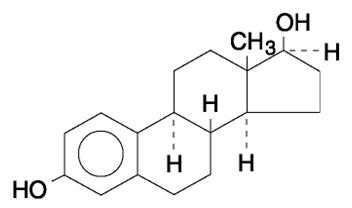
The molecular formula of estradiol is C18H2402. The molecular weight is 272.39
MINIVELLE is comprised of three layers. Proceeding from the visible surface toward the surface attached to the skin, these layers are (1) a polyester film laminate (2) an adhesive formulation containing estradiol, acrylic adhesive, silicone adhesive, oleyl alcohol, NF, povidone, USP and dipropylene glycol, and (3) a polyester release liner which is attached to the adhesive surface and must be removed before the system can be used.

The active component of the system is estradiol. The remaining components of the system are pharmacologically inactive.
12. CLINICAL PHARMACOLOGY
12.1 Mechanism of Action
Endogenous estrogens are largely responsible for the development and maintenance of the female reproductive system and secondary sexual characteristics. Although circulating estrogens exist in a dynamic equilibrium of metabolic interconversions, estradiol is the principal intracellular human estrogen and is substantially more potent than its metabolites, estrone and estriol, at the receptor level.
The primary source of estrogen in normally cycling adult women is the ovarian follicle, which secretes 70 to 500 mcg of estradiol daily, depending on the phase of the menstrual cycle. After menopause, most endogenous estrogen is produced by conversion of androstenedione, secreted by the adrenal cortex, to estrone in the peripheral tissues. Thus, estrone and the sulfate conjugated form, estrone sulfate, are the most abundant circulating estrogens in postmenopausal women.
Estrogens act through binding to nuclear receptors in estrogen responsive tissues. To date, two estrogen receptors have been identified. These vary in proportion from tissue to tissue.
Circulating estrogens modulate the pituitary secretion of the gonadotropins, luteinizing hormone (LH) and follicle stimulating hormone (FSH) through a negative feedback mechanism. Estrogens act to reduce the elevated concentrations of these hormones seen in postmenopausal women.
12.2 Pharmacodynamics
There are no pharmacodynamic data for MINIVELLE.
12.3 Pharmacokinetics
Absorption
In a single-dose, two way-crossover clinical study conducted in 96 healthy, non-smoking postmenopausal women under fed condition, MINIVELLE (0.1 mg per day) was bioequivalent to Vivelle (0.1 mg per day) based on estradiol exposure (AUC0-84) and estradiol peak concentration (Cmax) following a single-dose on the lower abdomen for 84 hours.
Estradiol pharmacokinetics were characterized in a separate open-label, single-center, randomized, single-dose, three-way crossover study conducted in 36 healthy, non-smoking postmenopausal women (aged 40 to 65 years). MINIVELLE delivering nominal estradiol of approximately 0.025 mg, 0.05 mg, and 0.1 mg per day were applied to the lower abdomen under fed state in a crossover fashion for 84 hours. The mean estradiol pharmacokinetics parameters are summarized in Table 2. AUC and Cmax are dose proportional from 0.025 mg to 0.1 mg per day.
| aMedian (minimum-maximum) | |||
| Parameter | 0.1 mg/day | 0.05 mg/day | 0.025 mg/day |
| AUC84 (pg•hr/mL) | 5875 (1857) | 3057 (980) | 1763 (600) |
| AUC120 (pg•hr/mL) | 6252 (1938) | 3320 (1038) | 1979 (648) |
| Cmax (pg/mL) | 117 (39.3) | 56.6 (17.6) | 30.3 (11.1) |
| Tmax (hr)a | 24.0 (8-60) | 24.0 (8-60) | 36.0 (8-84) |
Figure 1 illustrates the mean baseline-uncorrected estradiol serum concentrations of MINIVELLE at three different strengths.
Figure 1: Mean Baseline-Uncorrected Estradiol Serum Concentration-Time Profiles Following a Single Dose of MINIVELLE 0.1 mg per day (Treatment A), 0.05 mg per day (Treatment B), and 0.025 mg per day (Treatment C) (N=36)
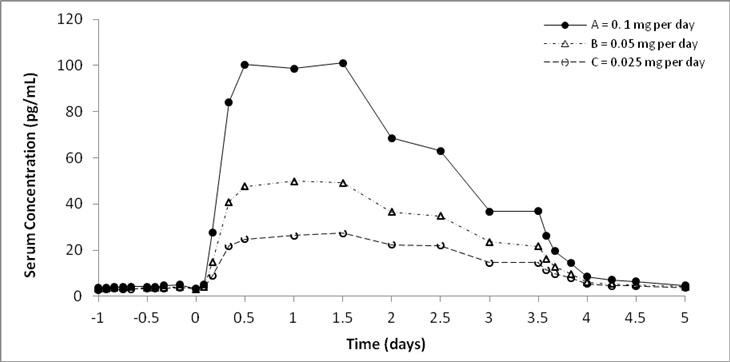
Distribution
The distribution of exogenous estrogens is similar to that of endogenous estrogens. Estrogens are widely distributed in the body and are generally found in higher concentrations in the sex hormone target organs. Estrogens circulate in the blood largely bound to SHBG and albumin.
Metabolism
Exogenous estrogens are metabolized in the same manner as endogenous estrogens. Circulating estrogens exist in a dynamic equilibrium of metabolic interconversions. These transformations take place mainly in the liver. Estradiol is converted reversibly to estrone, and both can be converted to estriol, which is a major urinary metabolite. Estrogens also undergo enterohepatic recirculation via sulfate and glucuronide conjugation in the liver, biliary secretion of conjugates into the intestine, and hydrolysis in the intestine followed by reabsorption. In postmenopausal women a significant portion of the circulating estrogens exist as sulfate conjugates, especially estrone sulfate, which serves as a circulating reservoir for the formation of more active estrogens.
Excretion
Estradiol, estrone and estriol are excreted in the urine along with glucuronide and sulfate conjugates. The mean half-life values of estradiol calculated from treatment groups in the bioequivalence study and dose-proportionality study after dosing with the MINIVELLE ranged from 6.2 to 7.9 hours. After removal of the transdermal systems, serum concentrations of estradiol and estrone returned to baseline concentrations within 24 hours.
Use in Specific Populations
No pharmacokinetic studies were conducted with MINIVELLE in specific populations, including patients with renal or hepatic impairment.
Adhesion and Adhesive Residue
Based on combined data from bioequivalence and dose proportionality studies consisting of 208 MINIVELLE observations, approximately 98 percent of the observations had an adhesion score of 0 (i.e., the skin adhesion rate was greater than or equal to 90 percent) over the 84-hour wear period. One subject had a complete detachment during the wear period. Approximately 65 percent of the transdermal systems evaluated in these studies were with MINIVELLE 0.1 mg per day (6.6 cm2 active surface area).
After removal of MINIVELLE, subjects had either no adhesive residue (score of 0) or light adhesive residue (score of 1). There were no subjects who had medium adhesive residue. Of the 208 MINIVELLE observations, 54 percent had light adhesive residue and 46 percent had no adhesive residue.
13. NONCLINICAL TOXICOLOGY
13.1 Carcinogenesis, Mutagenesis, Impairment of Fertility
Long-term, continuous administration of natural and synthetic estrogens in certain animal species increases the frequency of carcinomas of the breast, uterus, cervix, vagina, testis, and liver.
14. CLINICAL STUDIES
14.1 Effects on Vasomotor Symptoms
There have been no efficacy and safety trials conducted with MINIVELLE. In a pharmacokinetic study, MINIVELLE was shown to be bioequivalent to Vivelle.
In two controlled clinical trials with Vivelle, in a total of 356 subjects, the 0.075 and 0.1 mg doses were superior to placebo in relieving vasomotor symptoms at Weeks 4, 8 and 12 of treatment. In these studies, the 0.0375 and 0.05 mg doses did not differ from placebo at Week 4, therefore, a third 12-week placebo-controlled study in 255 subjects was performed with Vivelle to establish the efficacy of the lowest dose of 0.0375 mg. The baseline mean daily number of hot flushes in these 255 subjects was 11.5. Results at Weeks 4, 8, and 12 of treatment are shown in Figure 2.
Figure 2: Mean (SD) change from baseline in mean daily number of hot flushes for
Vivelle 0.0375 mg versus Placebo in a 12 week trial.
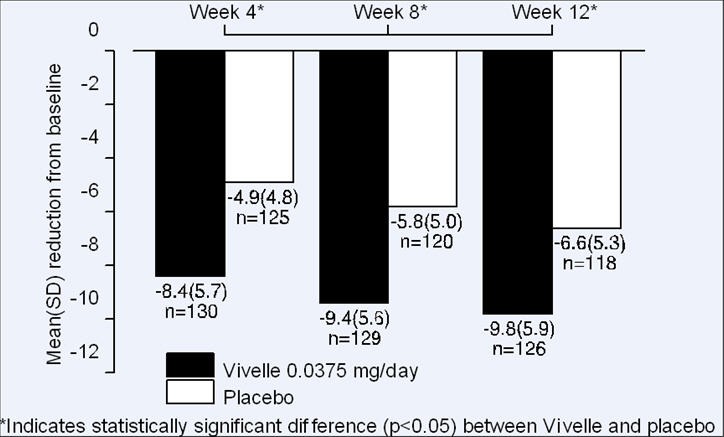
The 0.0375 mg dose was superior to placebo in reducing both the frequency and severity of vasomotor symptoms at Weeks 4, 8 and 12 of treatment.
14.2 Women’s Health Initiative Studies
The WHI enrolled approximately 27,000 predominantly healthy postmenopausal women in two substudies to assess the risks and benefits of daily oral CE (0.625 mg)-alone or in combination with MPA (2.5 mg) compared to placebo in the prevention of certain chronic diseases. The primary endpoint was the incidence of CHD (defined as nonfatal MI, silent MI and CHD death), with invasive breast cancer as the primary adverse outcome. A “global index” included the earliest occurrence of CHD, invasive breast cancer, stroke, PE, endometrial cancer (only in the CE plus MPA substudy), colorectal cancer, hip fracture, or death due to other cause. These substudies did not evaluate the effects of CE-alone or CE plus MPA on menopausal symptoms.
WHI Estrogen-Alone Substudy
The WHI estrogen-alone substudy was stopped early because an increased risk of stroke was observed, and it was deemed that no further information would be obtained regarding the risks and benefits of estrogen-alone in predetermined primary endpoints.
Results of the estrogen-alone substudy, which included 10,739 women (average 63 years of age, range 50 to 79; 75.3 percent White, 15.1 percent Black, 6.1 percent Hispanic, 3.6 percent Other), after an average follow- up of 7.1 years are presented in Table 3.
| a Adapted from numerous WHI publications. WHI publications can be viewed at www.nhlbi.nih.gov/whi. | |||
| b Nominal confidence intervals unadjusted for multiple looks and multiple comparisons. | |||
| c Results are based on centrally adjudicated data for an average follow-up of 7.1 years. | |||
| d Not included in “global index”. | |||
| e Results are based on an average follow-up of 6.8 years. | |||
| f All deaths, except from breast or colorectal cancer, definite or probable CHD, PE, or cerebrovascular disease. | |||
| g A subset of the events was combined in a “global index”, defined as the earliest occurrence of CHD events. invasive breast cancer, stroke, PE, endometrial cancer, colorectal cancer, hip fracture, or death due to other causes. | |||
| Event |
Relative Risk CE vs. Placebo (95% nCIb) |
CE n = 5,310) |
Placebo n = 5,429 |
|
Absolute Risk per 10,000 Women-Years |
|||
| CHD eventsc
Non-fatal MI c CHD deathc |
0.95 (0.78–1.16) 0.91 (0.73–1.14) 1.01 (0.71–1.43) |
54 40 16 |
57 43 16 |
| All Strokes c
Ischemic stroke c |
1.33 (1.15–1.68) 1.55 (1.19–2.01) |
45 38 |
33 25 |
| Deep vein thrombosisc,d | 1.47 (1.06–2.06) | 23 | 15 |
| Pulmonary embolismc | 1.37 (0.90–2.07) | 14 | 10 |
| Invasive breast cancerc | 0.80 (0.62–1.04) | 28 | 34 |
| Colorectal cancere | 1.08 (0.75–1.55) | 17 | 16 |
| Hip fracturec | 0.65 (0.45–0.94) | 12 | 19 |
| Vertebral fracturesc,d | 0.64 (0.44–0.93) | 11 | 18 |
| Lower arm/wrist fracturesc,d | 0.58 (0.47-0.72) | 35 | 59 |
| Total fracturesc,d | 0.71 (0.64–0.80) | 144 | 197 |
| Death due to other causese,f | 1.08 (0.88–1.32) | 53 | 50 |
| Overall mortalityc,d | 1.04 (0.88–1.22) | 79 | 75 |
| Global Indexg | 1.02 (0.92–1.13) | 206 | 201 |
For those outcomes included in the WHI “global index” that reached statistical significance, the absolute excess risk per 10,000 women-years in the group treated with CE-alone was 12 more strokes, while the absolute risk reduction per 10,000 women-years was 7 fewer hip fractures.⁹ The absolute excess risk of events included in the “global index” was a non-significant 5 events per 10,000 women-years. There was no difference between the groups in terms of all-cause mortality.
No overall difference for primary CHD events (nonfatal MI, silent MI and CHD death) and invasive breast cancer incidence in women receiving CE-alone compared to placebo was reported in final centrally adjudicated results from the estrogen-alone substudy, after an average follow-up of 7.1 years.
Centrally adjudicated results for stroke events from the estrogen-alone substudy, after an average follow-up of 7.1 years, reported no significant differences in distribution of stroke subtype or severity, including fatal strokes, in women receiving CE-alone compared to placebo. Estrogen-alone increased the risk for ischemic stroke, and this excess risk was present in all subgroups of women examined.¹⁰
Timing of the initiation of estrogen-alone therapy relative to the start of menopause may affect the overall risk benefit profile. The WHI estrogen-alone substudy, stratified by age, showed in women 50 to 59 years of age a non-significant trend toward reduced risk for CHD [hazard ratio (HR) 0.63 (95 percent CI, 0.36-1.09)] and overall mortality [HR 0.71 (95 percent CI, 0.46-1.11)].
WHI Estrogen Plus Progestin Substudy
The WHI estrogen plus progestin substudy was stopped early. According to the predefined stopping rule, after an average follow-up of 5.6 years of treatment, the increased risk of invasive breast cancer and cardiovascular events exceeded the specified benefits included in the “global index”. The absolute excess risk of events included in the “global index” was 19 per 10,000 women-years.
For those outcomes included in the WHI “global index” that reached statistical significance after 5.6 years of follow-up, the absolute excess risks per 10,000 women-years in the group treated with CE plus MPA were 7 more CHD events, 8 more strokes, 10 more PEs, and 8 more invasive breast cancers, while the absolute risk reduction per 10,000 women-years were 6 fewer colorectal cancers and 5 fewer hip fractures.
Results of the CE plus MPA substudy, which included 16,608 women (average 63 years of age, range 50 to 79; 83.9 percent White, 6.8 percent Black, 5.4 percent Hispanic, 3.9 percent Other) are presented in Table 4. These results reflect centrally adjudicated data after an average follow-up of 5.6 years.
| aAdapted from numerous WHI publications. WHI publications can be viewed at www.nhlbi.nih.gov/whi. | |||
| bResults are based on centrally adjudicated data. | |||
| cNominal confidence intervals unadjusted for multiple looks and multiple comparisons. | |||
| dNot included in “global index”. | |||
| eIncludes metastatic and non-metastatic breast cancer, with the exception of in situ breast cancer. | |||
| fAll deaths, except from breast or colorectal cancer, definite or probable CHD, PE, or cerebrovascular disease. | |||
| gA subset of the events was combined in a “global index”, defined as the earliest occurrence of CHD events, invasive breast cancer, stroke, pulmonary embolism, endometrial cancer, colorectal cancer, hip fracture, or death due to other causes. | |||
| Event |
Relative Risk CE/MPA vs. Placebo (95% nCIc) |
CE/MPA (n = 8,506) |
Placebo (n = 8, 102) |
|
Absolute Risk per 10,000 Women-Years |
|||
| CHD events Non-fatal MI CHD death |
1.23 (0.99–1.53) 1.28 (1.00–1.63) 1.10 (0.70–1.75) |
41 31 8 |
34 25 8 |
| All strokes Ischemic stroke |
1.31 (1.03–1.68) 1.44 (1.09–1.90) |
33 26 |
25 18 |
| Deep vein thrombosisd | 1.95 (1.43–2.67) | 26 | 13 |
| Pulmonary embolism | 2.13 (1.45–3.11) | 18 | 8 |
| Invasive breast cancere | 1.24 (1.01–1.54) | 41 | 33 |
| Colorectal cancer | 0.61 (0.42–0.87) | 10 | 16 |
| Endometrial cancerd | 0.81 (0.48–1.36) | 6 | 7 |
| Cervical cancerd | 1.44 (0.47–4.42) | 2 | 1 |
| Hip fracture | 0.67 (0.47–0.96) | 11 | 16 |
| Vertebral fracturesd | 0.65 (0.46–0.92) | 11 | 17 |
| Lower arm/wrist fracturesd |
0.71 (0.59–0.85) | 44 | 62 |
| Total fracturesd | 0.76 (0.69–0.83) | 152 | 199 |
| Overall mortalityf | 1.00 (0.83-1.19) | 52 | 52 |
| Global Index g | 1.13 (1.02-1.25) | 184 | 165 |
Timing of the initiation of estrogen plus progestin therapy relative to the start of menopause may affect the overall risk benefit profile. The WHI estrogen plus progestin substudy stratified for age showed in women 50 to 59 years of age a non-significant trend toward reduced risk for overall mortality [HR 0.69 (95 percent CI, 0.44-1.07)].
14.3 Women’s Health Initiative Memory Study
The WHIMS estrogen-alone ancillary study of WHI enrolled 2,947 predominantly healthy hysterectomized postmenopausal women 65 to 79 years of age (45 percent were 65 to 69 years of age, 36 percent were 70 to 74 years of age, and 19 percent were 75 years of age and older) to evaluate the effects of daily CE (0.625 mg)-alone on the incidence of probable dementia (primary outcome) compared to placebo.
After an average follow-up of 5.2 years, the relative risk of probable dementia for CE-alone versus placebo was 1.49 (95 percent CI, 0.83-2.66). The absolute risk of probable dementia for CE-alone versus placebo was 37 versus 25 cases per 10,000 women-years. Probable dementia as defined in this study included Alzheimer’s disease (AD), vascular dementia (VaD) and mixed type (having features of both AD and VaD). The most common classification of probable dementia in the treatment group and the placebo group was AD. Since the ancillary study was conducted in women 65 to 79 years of age, it is unknown whether these findings apply to younger postmenopausal women [see Warnings and Precautions ( 5.3 ) and Use in Specific Populations ( 8.5 )].
The WHIMS estrogen plus progestin ancillary study enrolled 4,532 predominantly healthy postmenopausal women 65 years of age and older (47 percent were 65 to 69 years of age, 35 percent were 70 to 74 years of age, and 18 percent were 75 years of age and older) to evaluate the effects of daily CE (0.625 mg) plus MPA (2.5 mg) on the incidence of probable dementia (primary outcome) compared to placebo.
After an average follow-up of 4 years, the relative risk of probable dementia for CE plus MPA versus placebo was 2.05 (95 percent CI, 1.21- 3.48). The absolute risk of probable dementia for CE plus MPA versus placebo was 45 versus 22 per 10,000 women-years. Probable dementia as defined in this study included AD, VaD and mixed type (having features of both AD and VaD). The most common classification of probable dementia in the treatment group and the placebo group was AD. Since the ancillary study was conducted in women 65 to 79 years of age, it is unknown whether these findings apply to younger postmenopausal women [see Warnings and Precautions ( 5.3 ) and Use in Specific Populations ( 8.5 )].
When data from the two populations were pooled as planned in the WHIMS protocol, the reported overall relative risk for probable dementia was 1.76 (95 percent CI, 1.19-2.60). Differences between groups became apparent in the first year of treatment. It is unknown whether these findings apply to younger postmenopausal women [see Warnings and Precautions ( 5.3 ) and Use in Specific Populations ( 8.5 )].
15. REFERENCES
- Rossouw JE, et al. Postmenopausal Hormone Therapy and Risk of Cardiovascular Disease by Age and Years Since Menopause. JAMA.2007;297:1465-1477.
- Hsia J, et al. Conjugated Equine Estrogens and Coronary Heart Disease. Arch Int Med. 2006;166:357–365.
- Curb JD, et al. Venous Thrombosis and Conjugated Equine Estrogen in Women Without a Uterus. Arch Int Med. 2006; 166:772-780.
- Cushman M, et al. Estrogen Plus Progestin and Risk of Venous Thrombosis. JAMA. 2004;292:1573-1580.
- Stefanick ML, et al. Effects of Conjugated Equine Estrogens on Breast Cancer and Mammography Screening in Postmenopausal Women with Hysterectomy. JAMA. 2006;295:1647-1657.
- Chlebowski RT, et al. Influence of Estrogen Plus Progestin on Breast Cancer and Mammography in Healthy Postmenopausal Women. JAMA. 2003;289:3234-3253.
- Anderson GL, et al. Effects of Estrogen Plus Progestin on Gynecologic Cancers and Associated Diagnostic Procedures. JAMA. 2003;290:1739-1748.
- Shumaker SA, et al. Conjugated Equine Estrogens and Incidence of Probable Dementia and Mild Cognitive Impairment in Postmenopausal Women. JAMA. 2004;291:2947-2958.
- Jackson RD, et al. Effects of Conjugated Equine Estrogen on Risk of Fractures and BMD in Postmenopausal Women With Hysterectomy: Results From the Women's Health Initiative Randomized Trial. J Bone Miner Res. 2006;21:817-828.
- Hendrix SL, et al. Effects of Conjugated Equine Estrogen on Stroke in the Women's Health Initiative. Circulation. 2006;113:2425-2434.
16. HOW SUPPLIED/STORAGE AND HANDLING
16.1 How Supplied
MINIVELLE (estradiol transdermal system), 0.0375 mg per day - each 2.48 cm2 system contains 0.62 mg of estradiol USP for nominal* delivery of 0.0375 mg of estradiol per day.
Patient Calendar Pack of 8 Systems…………………………………..NDC 68968-6637-8
Carton of 3 Patient Calendar Packs of 8 Systems…………………….NDC 68968-6637-3
MINIVELLE (estradiol transdermal system), 0.05 mg per day - each 3.3 cm2 system contains 0.83 mg of estradiol USP for nominal* delivery of 0.05 mg of estradiol per day.
Patient Calendar Pack of 8 Systems………………………………….NDC 68968-6650-8
Carton of 3 Patient Calendar Packs of 8 Systems……………………NDC 68968-6650-3
MINIVELLE (estradiol transdermal system), 0.075 mg per day - each 4.95 cm2 system contains 1.24 mg of estradiol USP for nominal* delivery of 0.075 mg of estradiol per day.
Patient Calendar Pack of 8 Systems………………………………….NDC 68968-6675-8
Carton of 3 Patient Calendar Packs of 8 Systems……………………NDC 68968-6675-3
MINIVELLE (estradiol transdermal system), 0.1 mg per day - each 6.6 cm2 system contains 1.65mg of estradiol USP for nominal* delivery of 0.1 mg of estradiol per day.
Patient Calendar Pack of 8 Systems………………………………….NDC 68968-6610-8
Carton of 3 Patient Calendar Packs of 8 Systems……………………NDC 68968-6610-3
*See Description
16.2 Storage and Handling
Store at room temperature 20°C to 25°C (68°F to 77°F); excursions permitted between 15°C and 30°C (59°F and 86°F).
Do not store unpouched. Apply immediately upon removal from the protective pouch.
Used transdermal systems still contain active hormone. To discard, fold the sticky side of the transdermal system together, place it in a sturdy child-proof container, and place this container in the trash. Used transdermal systems should not be flushed in the toilet.
17. PATIENT COUNSELING INFORMATION
See FDA-approved patient labeling (Patient Information and Instructions for Use)
17.1 Vaginal Bleeding
Inform postmenopausal women of the importance of reporting unusual vaginal bleeding to their healthcare providers as soon as possible [see Warnings and Precautions ( 5.2 )].
17.2 Possible Serious Side Effects with Estrogen-Alone Therapy
Inform postmenopausal women of possible serious adverse reactions of estrogen-alone therapy including Cardiovascular Disorders, Malignant Neoplasms, and Probable Dementia [see Warnings and Precautions ( 5.1 , 5.2 , 5.3 )].
17.3 Possible Less Serious but Common Side Effects with Estrogen-Alone Therapy
Inform postmenopausal women of possible less serious but common adverse reactions of estrogen-alone therapy such as headache, breast pain and tenderness, nausea and vomiting.
Patient Information
MINIVELLE (MIN-ee-vell)
(estradiol transdermal system)
Read this patient information before you start using MINIVELLE and each time you get a refill. There may be new information. This information does not take the place of talking to your healthcare provider about your menopausal symptoms or your treatment.
What is the most important information I should know about MINIVELLE (an estrogen hormone)?
- Using estrogen-alone may increase your chance of getting cancer of the uterus (womb). Report any unusual vaginal bleeding right away while you are using MINIVELLE. Vaginal bleeding after menopause may be a warning sign of cancer of the uterus (womb). Your healthcare provider should check any unusual vaginal bleeding to find out the cause
- Do not use estrogen-alone to prevent heart disease, heart attacks, strokes, or dementia (decline in brain function)
- Using estrogen-alone may increase your chances of getting strokes or blood clots
- Using estrogen-alone may increase your chance of getting dementia, based on a study of women 65 years of age or older
- Do not use estrogens with progestins to prevent heart disease, heart attacks, strokes, or dementia
- Using estrogens with progestins may increase your chances of getting heart attacks, strokes, breast cancer, or blood clots
- Using estrogens with progestins may increase your chance of getting dementia, based on a study of women 65 years of age or older
- You and your healthcare provider should talk regularly about whether you still need treatment with MINIVELLE
What is MINIVELLE?
MINIVELLE is a prescription medicine patch that contains estradiol (an estrogen hormone).
What is MINIVELLE™ used for?
THE MINIVELLE patch is used after menopause to:
-
Reduce moderate to severe hot flashes
Estrogens are hormones made by a woman’s ovaries. The ovaries normally stop making estrogens when a woman is between 45 and 55 years old. This drop in body estrogen levels causes the “change of life” or menopause (the end of monthly menstrual periods). Sometimes, both ovaries are removed during an operation before natural menopause takes place. The sudden drop in estrogen levels causes “surgical menopause.”
When the estrogen levels begin dropping, some women develop very uncomfortable symptoms, such as feelings of warmth in the face, neck, and chest or sudden strong feelings of heat and sweating (“hot flashes” or “hot flushes”). In some women, the symptoms are mild and they will not need treatment with estrogen therapy. In other women, symptoms can be more severe. You and your healthcare provider should talk regularly about whether or not you still need treatment with MINIVELLE.
Who should not use MINIVELLE?
Do not start using MINIVELLE if you:
-
have unusual vaginal bleeding
Vaginal bleeding after menopause may be a warning sign of cancer of the uterus (womb). Your healthcare provider should check any unusual vaginal bleeding to find out the cause. -
currently have or have had certain cancers
Estrogens may increase the chances of getting certain types of cancers, including cancer of the breast or uterus. If you have or have had cancer, talk with your healthcare provider about whether you should use MINIVELLE. - had a stroke or heart attack
- currently have or have had blood clots
- currently have or have had liver problems
- have been diagnosed with a bleeding disorder
-
are allergic to MINIVELLE or any of its ingredients
See the list of ingredients in MINIVELLE at the end of this leaflet. -
think you may be pregnant
MINIVELLE is not for pregnant women. If you think you may be pregnant, you should have a pregnancy test and know the results. Do not take MINIVELLE if the test is positive and talk to your healthcare provider.
What should I tell my healthcare provider before I use MINIVELLE?
Before you use MINIVELLE, tell your healthcare provider if you:
-
have any unusual vaginal bleeding
Vaginal bleeding after menopause may be a warning sign of cancer of the uterus (womb). Your healthcare provider should check any unusual vaginal bleeding to find out the cause. -
have any other medical conditions
Your healthcare provider may need to check you more carefully if you have certain conditions such as asthma (wheezing), epilepsy (seizures), diabetes, migraine, endometriosis, lupus, or problems with your heart, liver, thyroid, kidneys, or have high calcium levels in your blood. -
are going to have surgery or will be on bed rest.
Your healthcare provider will let you know if you need to stop using MINIVELLE. -
are breast feeding
The hormone in MINIVELLE can pass into your breast milk.
Tell your healthcare provider about all the medicines you take including prescription and nonprescription medicines, vitamins and herbal supplements. Some medicines may affect how MINIVELLE works. MINIVELLE may also affect how your other medicines work. Keep a list of your medicines and show it to your healthcare provider and pharmacist when you get a new medicine.
How should I use MINIVELLE?
For detailed instructions, see the step-by-step instructions for using MINIVELLE at the end of this Patient Information
- Use MINIVELLE exactly as your healthcare provider tells you to use it
- MINIVELLE is for skin use only
- Change your MINIVELLE patch 2 times a week or every 3 to 4 days
- Apply your MINIVELLE patch to a clean, dry area on your lower abdomen or buttocks. This area must be clean, dry, and free of powder, oil or lotion for your patch to stick to your skin
- Apply your MINIVELLE patch to a different area of your abdomen or your buttocks each time. Do not use the same application site 2 times in the same week.
- Do not apply MINIVELLE to your breasts
- If you forget to apply a new MINIVELLE patch, you should apply a new patch as soon as possible.
- You and your healthcare provider should talk regularly (every 3 to 5 months) about your dose and whether you still need treatment with MINIVELLE.
How to Change MINIVELLE
- When changing the patch, peel off the used patch slowly from the skin
- After removal of MINIVELLE, patients usually have either no adhesive residue or light adhesive residue. If any adhesive residue remains on your skin after removing the patch, allow the area to dry for 15 minutes. Then, gently rub the area with oil or lotion to remove the adhesive from your skin
- Keep in mind, the new patch must be applied to a different area of your abdomen or buttocks. This area must be clean, dry, cool and free of powder, oil or lotion.
What are the possible side effects of MINIVELLE?
Side effects are grouped by how serious they are and how often they happen when you are treated.
Serious, but less common side effects include:
- heart attack
- stroke
- blood clots
- dementia
- breast cancer
- cancer of the lining of the uterus (womb)
- cancer of the ovary
- high blood pressure
- high blood sugar
- gallbladder disease
- liver problems
- changes in your thyroid hormone levels
- enlargement of benign tumors (“fibroids”)
Call your healthcare provider right away if you get any of the following warning signs or any other unusual symptoms that concern you:
- new breast lumps
- unusual vaginal bleeding
- changes in vision or speech
- sudden new severe headaches
- severe pains in your chest or legs with or without shortness of breath, weakness and fatigue
Less serious, but common side effects include:
- headache
- breast pain
- irregular vaginal bleeding or spotting
- stomach or abdominal cramps, bloating
- nausea and vomiting
- hair loss
- fluid retention
- vaginal yeast infection
- redness and/or irritation at patch placement site
These are not all the possible side effects of MINIVELLE. For more information, ask your healthcare provider or pharmacist. Tell your healthcare provider if you have any side effects that bother you or does not go away. You may report side effects to Noven at 1-800-455-8070 or to FDA at 1-800-FDA-1088.
What can I do to lower my chances of a serious side effect with MINIVELLE?
- Talk with your healthcare provider regularly about whether you should continue taking MINIVELLE
- If you have a uterus, talk to your healthcare provider about whether the addition of a progestin is right for you
- The addition of a progestin is generally recommended for a woman with a uterus to reduce the chance of getting cancer of the uterus (womb).
- See your healthcare provider right away if you get vaginal bleeding while using MINIVELLE
- Have a pelvic exam, breast exam and mammogram (breast X-ray) every year unless your healthcare provider tells you something else
- If members of your family have had breast cancer or if you have ever had breast lumps or an abnormal mammogram, you may need to have breast exams more often
- If you have high blood pressure, high cholesterol (fat in the blood), diabetes, are overweight, or if you use tobacco, you may have higher chances of getting heart disease
Ask your healthcare provider for ways to lower your chances of getting heart disease.
How should I store and throw away used MINIVELLE patches?
- Store at room temperature 68°F to 77°F (20°C to 25°C)
- Do not store MINIVELLE patches outside of their pouches. Apply immediately upon removal from the protective pouch
- Used patches still contain estrogen. To throw away the patch, fold the sticky side of the patch together, place it in a sturdy child-proof container, and place this container in the trash. Used patches should not be flushed in the toilet
KEEP MINIVELLE and all other medicines out of the reach of children
General information about safe and effective use of MINIVELLE
Medicines are sometimes prescribed for conditions that are not mentioned in patient information leaflets. Do not use MINIVELLE for conditions for which it was not prescribed. Do not give MINIVELLE to other people, even if they have the same symptoms you have. It may harm them.
This leaflet summarizes the most important information about MINIVELLE. If you would like more information, talk with your healthcare provider or pharmacist. You can ask your healthcare provider or pharmacist for information about MINIVELLE that is written for health professionals.
For more information, go to www.minivelle.com or call Noven Pharmaceuticals Inc at 1-800-455-8070.
What are the ingredients in MINIVELLE?
Active ingredient: estradiol
Inactive ingredients: Polyester film laminate, acrylic and silicone adhesives, oleyl alcohol, NF, povidone, USP and dipropylene glycol and a polyester release liner
Instructions for Use
MINIVELLE (MIN-ee-vell)
(estradiol transdermal system)
Read this PATIENT INFORMATION before you start using MINIVELLE and each time you get a refill. There may be new information. This information does not take the place of talking to your healthcare provider about your menopausal symptoms or your treatment.
You will need the following supplies (See Figure A).
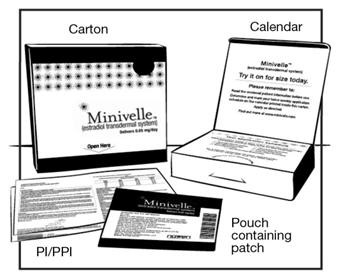
Figure A
Step 1: Pick the days you will change your patch.
- You will need to change your patch 2 times a week or every 3 to 4 days. Use the calendar printed inside your carton to choose the 2 days you will change your patch (See Figure B).
- Remember to change your patch on the same 2 days you marked on your calendar. If you forget to change your patch on the correct date, apply a new patch as soon as you remember, and continue to follow your original schedule
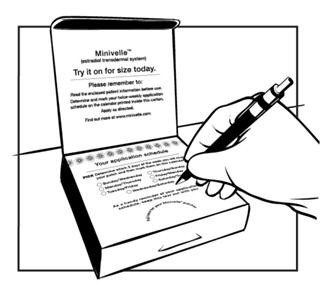
Figure B
Step 2. Remove the MINIVELLE patch from the pouch.
- Remove the patch from its protective pouch by tearing at the notch (do not use scissors,See Figure C).
- Do not remove your patch from the protective pouch until you are ready to apply it

Figure C
Step 3. Remove half of the adhesive liner (See Figure D).

Figure D
Step 4. Placing the patch on your skin.
- Hold the part of the patch that still has the adhesive liner on it
- Avoid touching the sticky half of the patch with your fingers
- Apply the exposed sticky half of the patch to 1 of the areas of skin shown below (See Figures E and F).
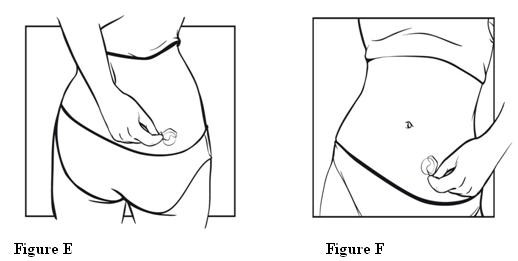
Note:
- Avoid the waistline, since clothing and belts may cause the patch to be rubbed off
- Do not apply the patch to your breasts
- Only apply the patch to skin that is clean, dry, and free of any powder, oil, or lotion
- You should not apply the patch to injured, burned, or irritated skin, or areas with skin conditions (such as birth marks, tattoos, or that is very hairy)
Step 5: Press the patch firmly onto your skin.
- Remove the remaining half of the adhesive liner and press the entire patch into place with the palm of your hand for 10 seconds
- Rub the edges of the patch with your fingers to make sure that it will stick to your skin (See Figure G).

Figure G
Note:
- Showering will not cause your patch to fall off
- If your patch falls off reapply it. If you cannot reapply the patch, apply a new patch to another area (See Figures E and D) and continue to follow your original placement schedule
- If you stop using your MINIVELLE patch or forget to apply a new patch as scheduled, you may have spotting, or bleeding, and recurrence of symptoms
Step 6: Throwing away your used patch.
- When it is time to change your patch, remove the old patch before you apply a new patch
- To throw away the patch, fold the sticky side of the patch together, place it in a sturdy child-proof container, and place this container in the trash. Used patches should not be flushed in the toilet
This Patient Information and Instructions for Use have been approved by the U.S Food and Drug Administration.
Manufactured by:
Noven Pharmaceuticals Inc.
Miami, FL 33186
Approved 10/2012
Package Label - Principal Display Panel – 0.0375mg Pouch
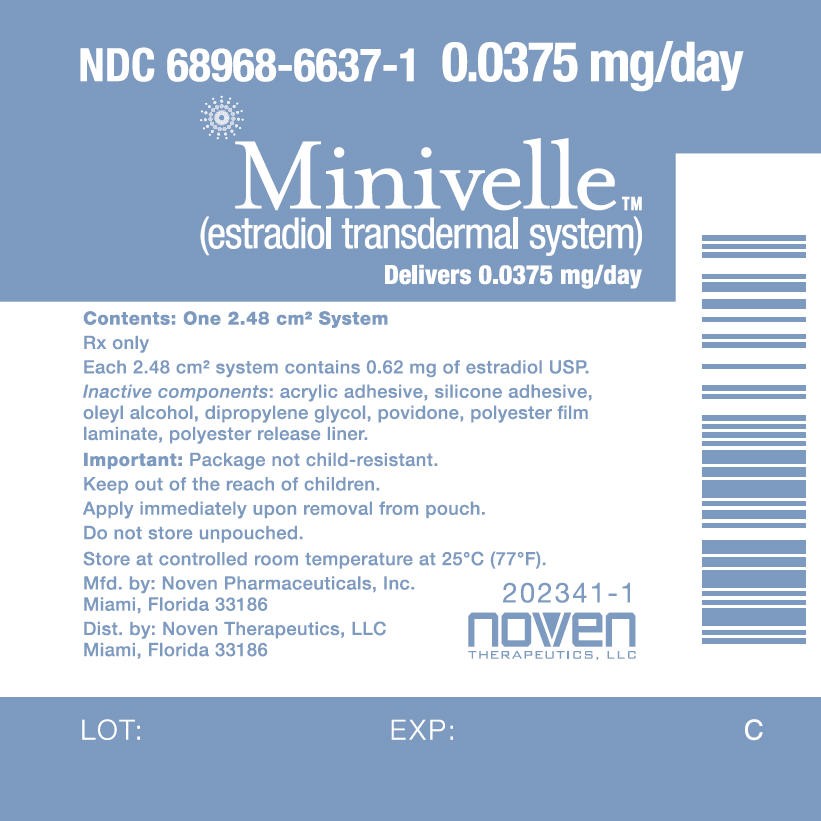
Package Label - Principal Display Panel – 0.0375mg Carton
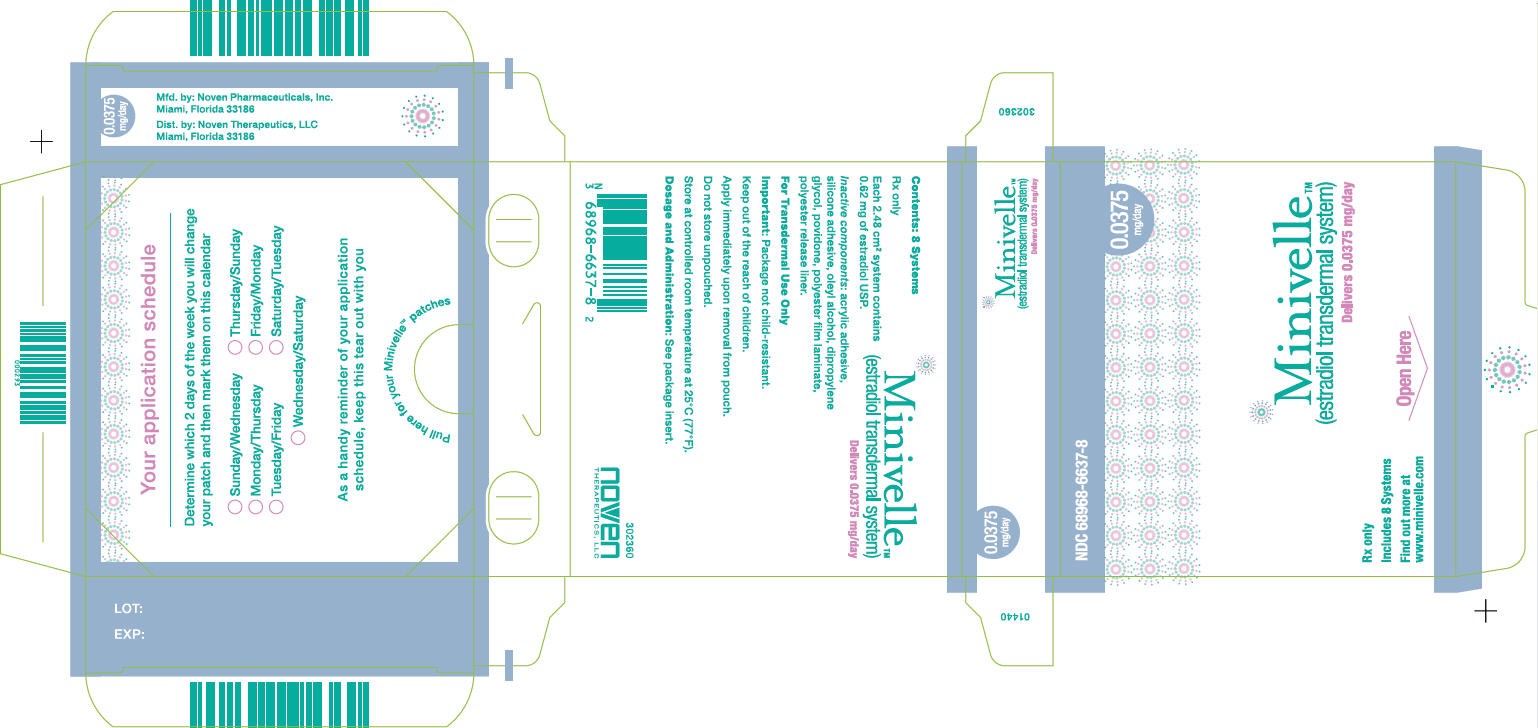
Package Label - Principal Display Panel – 0.05mg Pouch
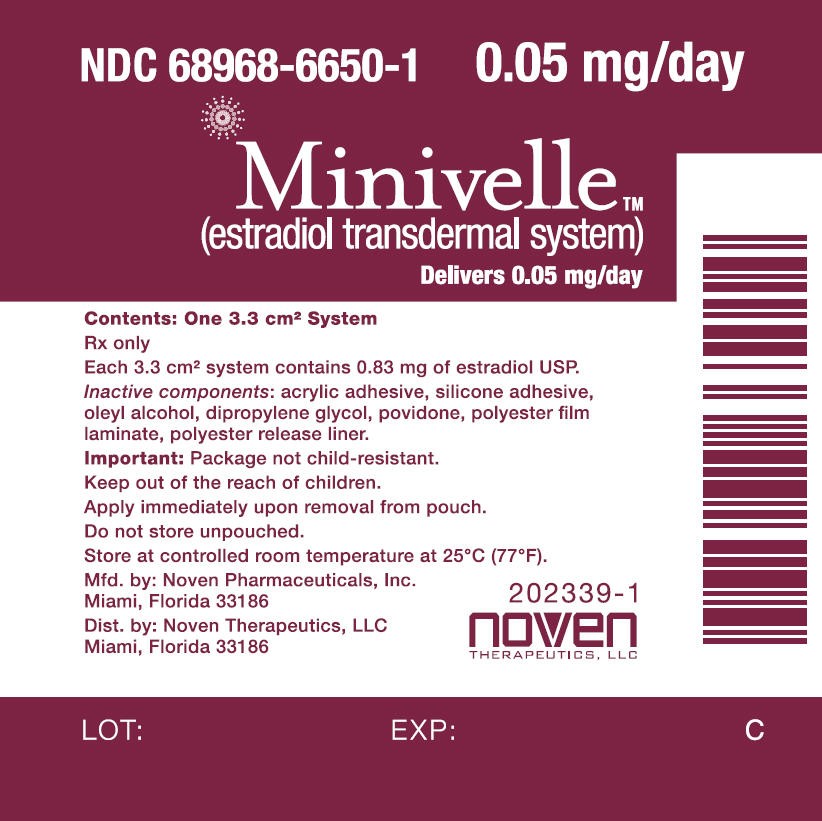
Package Label - Principal Display Panel – 0.05mg Carton
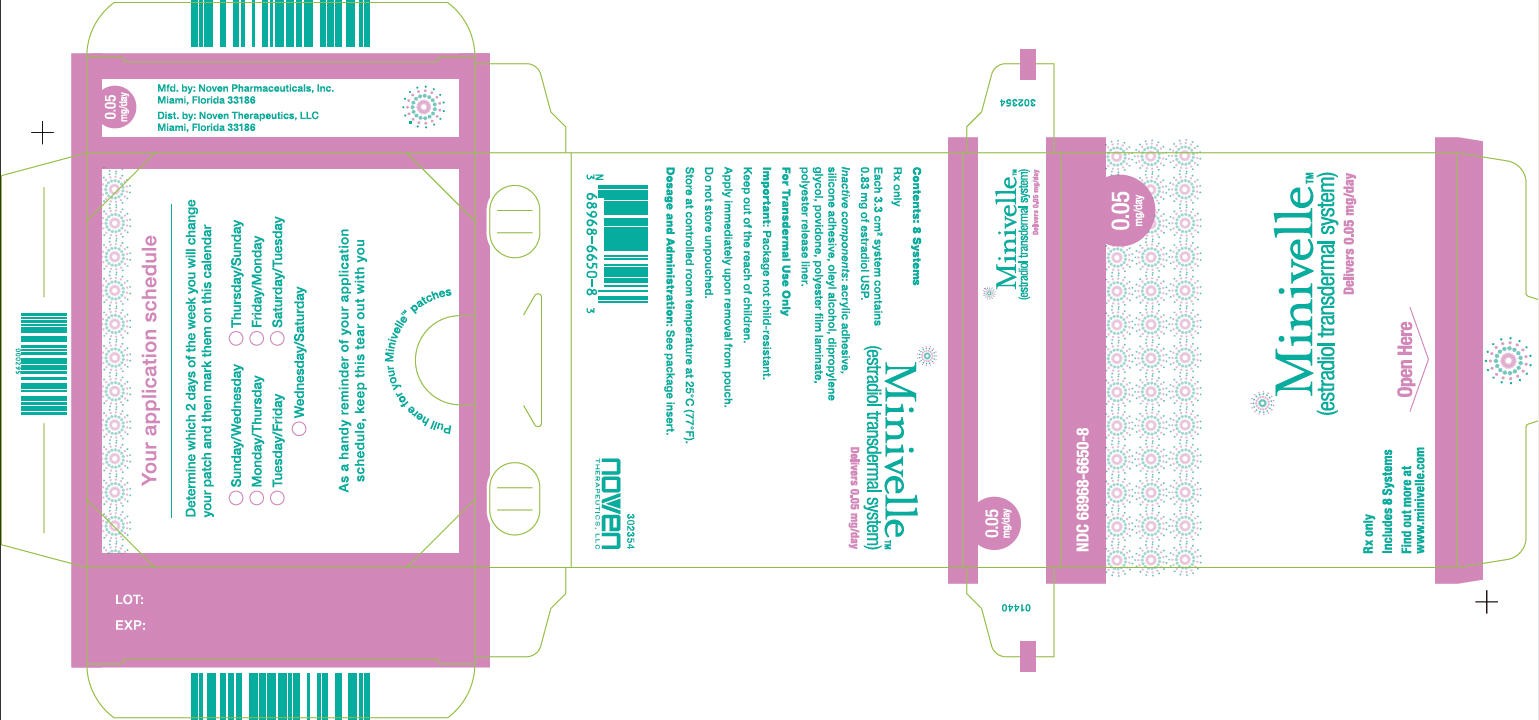
Package Label - Principal Display Panel – 0.075mg Pouch

Package Label - Principal Display Panel – 0.075mg Carton
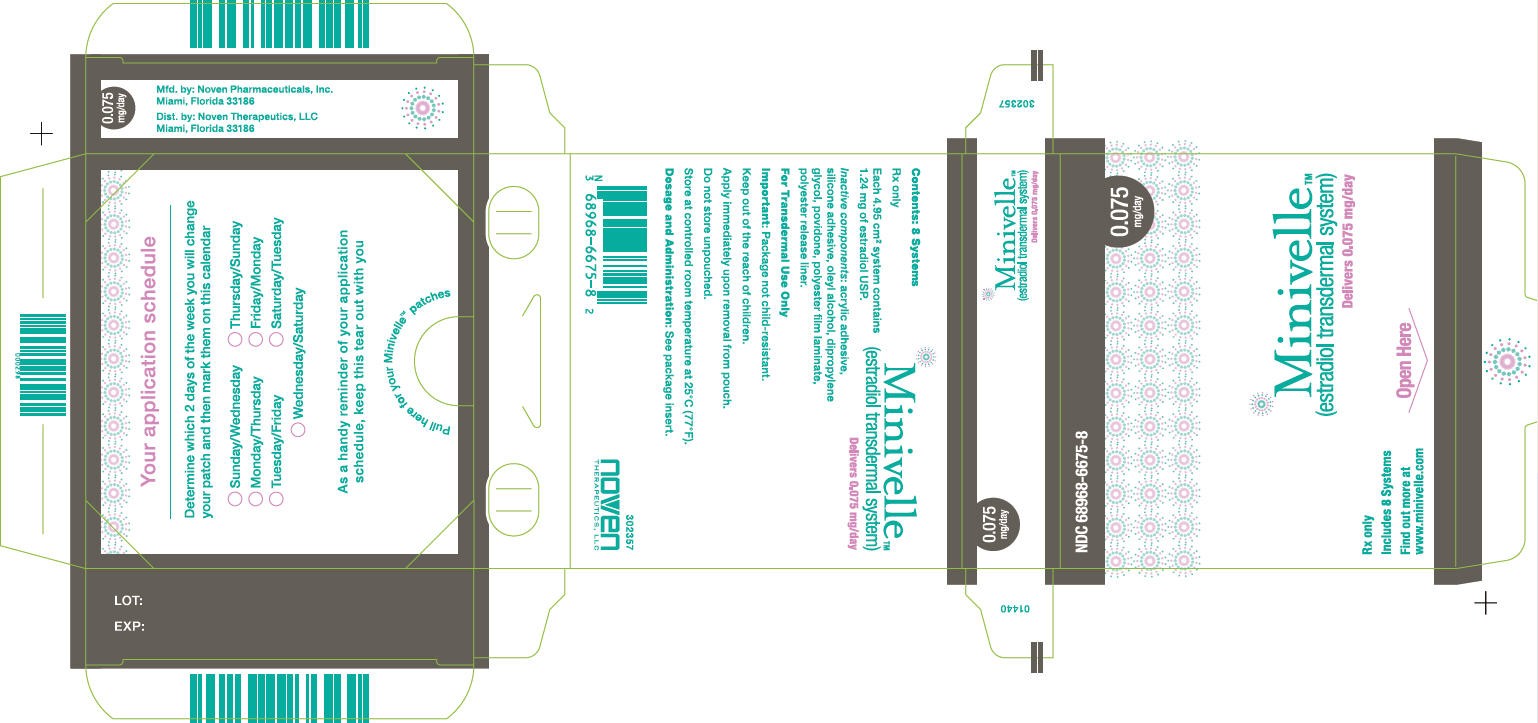
Package Label - Principal Display Panel – 0.1mg Pouch

Package Label - Principal Display Panel – 0.1mg Carton
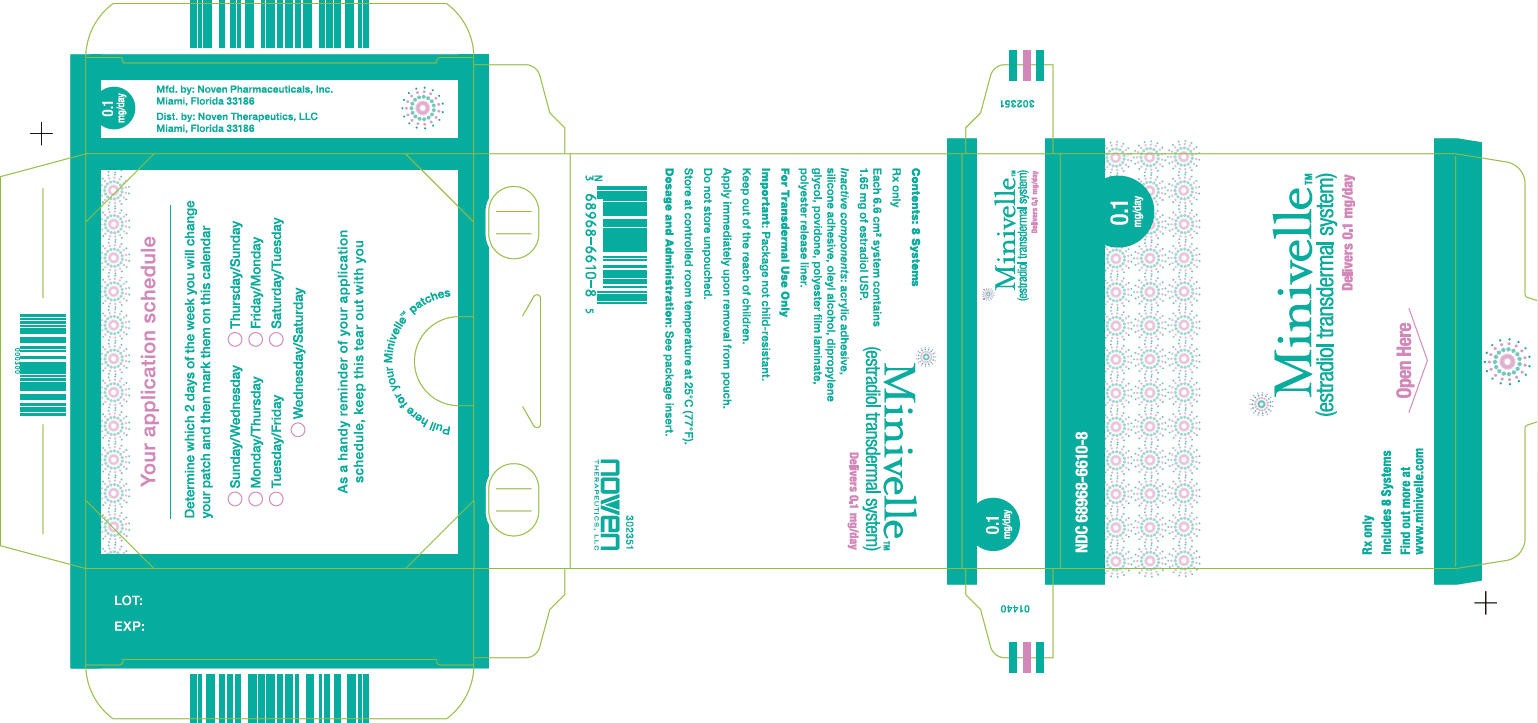
Minivelle(estradiol transdermal system) FILM, EXTENDED RELEASE
| |||||||||||||||||||||||||||||||||||||||||||||||||||||||||||||||||||||||||||
Minivelle(estradiol transdermal system) FILM, EXTENDED RELEASE
| |||||||||||||||||||||||||||||||||||||||||||||||||||||||||||||||||||||||||||
Minivelle(estradiol transdermal system) FILM, EXTENDED RELEASE
| |||||||||||||||||||||||||||||||||||||||||||||||||||||||||||||||||||||||||||
Minivelle(estradiol transdermal system) FILM, EXTENDED RELEASE
| |||||||||||||||||||||||||||||||||||||||||||||||||||||||||||||||||||||||||||